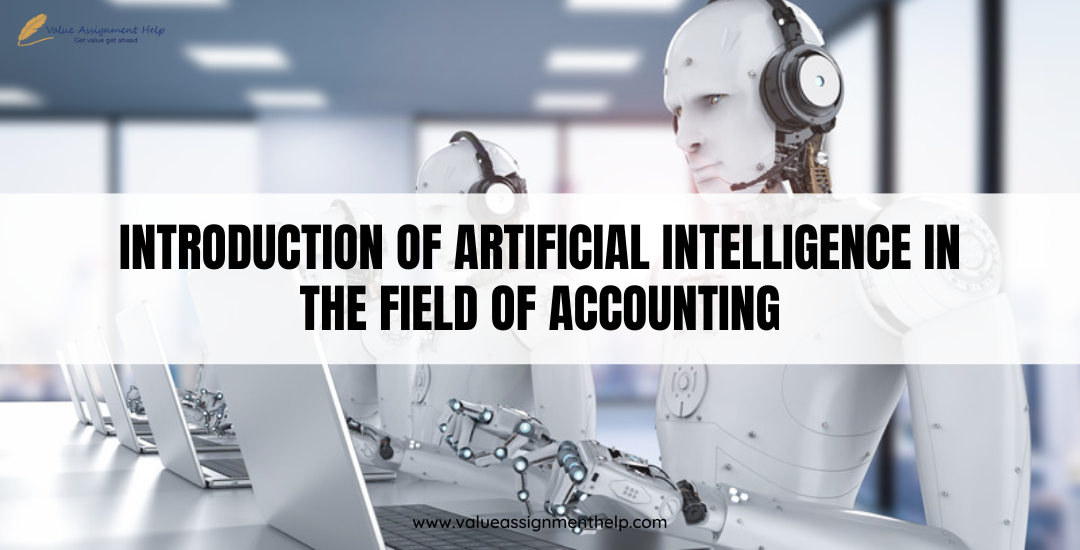
Search Assignments
Table of Contents
Our Experts

Search Assignments

Customers Reviews
Humans, a remarkably peculiar species, have never failed to devise innovative ways to simplify things. The genius mind and idea-generating capabilities of humans have always been the subject of keen interest for academia and scientists. Humans, like other species, can reproduce their “genetic off-springs” that are physically and mentally alike but humans as a race have the power to bring forth “off-springs” which are far more capable than us.

The offspring we refer to is “human-created technology”, which can replicate human contemplation and much more. For many decades, scientists have been mending their way into the progressive evolution of technology created by humans. All this has been made possible with the developments in artificial intelligence.
From sending humans to outer space to creating human-like robots called Humanoids, Artificial intelligence has taken a massive leap into the future. Artificial intelligence replicates natural human intelligence artificially through raw data inputs and complex code development called “progressive learning”.
Artificial intelligence has been employed to develop search engines, data optimization and image recognition; still, with changing times, the applications of the A.I. have been substituted with far more complex neural designs, cloud computing and data mining.
Artificial intelligence, commonly abbreviated as A.I., was founded in 1956 by academia. Soon after, the plans to further research were dropped due to a lack of funding and vision. The early development in the field simulated the human brain to replicate the critical problem-solving technique of the rain and develop logic. However, at that time, the idea of artificial intelligence was discarded, considering the complexity and infeasibility of the program.
Decades later, in the early 2000s, the developments were slow, but this time, gradual improvements in the field, such as machine learning, proved fruitful for the technology.
The touch of artificial intelligence has transformed every technological field remarkably. Recent developments in computer technology have made journey to other celestial planets easy. The invention of human-looking robots transformed the way technology was ever perceived. Medical sciences have developed new and precise ways to cure diseases, all with the help of A.I.
Even non-technical fields are not void of the magical touch of A.I. With the development of A.I., Education, finance and auditing processes are impacted. But considering the potential and the impacts of the application of A.I., we believe one field in dire need of attention today is Auditing. So, we present this article to cast some light on all the aspects of Auditing about A.I. However, before diving into the drivers of A.I. in auditing and its impacts, let us first familiarize ourselves with the concept of auditing.
Auditing is a detailed evaluation of any organization, its operations and the outputs to facilitate businesses to revamp their approach. For any business, the idea of auditing is to bring forth third-party opinion based on financial statements of the business meticulously derived post organizing, processing, sorting and reviewing the business's financial affairs. A suggestive report is provided after the analysis presenting a reliable opinion of the Audit. Auditing is the process of confirming the actuality of reflected data by checking supporting documents for the data.
It is a familiar yet crucial practice for a business. Via cross-checking the data and documents, the underlying truth of “business health” could be determined that it is usually hidden behind the façade. However, to cast light on the truth, a lot of data must be processed to leave no stone unturned. This labels auditing a time-consuming and labour-intensive process, along with utilizing a punctilious workforce.
In contemporary history, the first written auditing records were found in 1844 in Britain, when British Parliament passed the Joint Stock Companies act.
However, auditing did not start in 1844 but existed long before. In ancient times, the practice of the verbal auditing process was prevalent. Records of auditing in the form of checking activities have been found in China, Egypt and Greece civilizations. The first auditing record was extracted from ancient Persia for King Darius (522 to 486 B.C.), where audits would orally cross-verify the business affairs of the king.
Since then, the auditing process has changed from verbal to written form. In addition, with the introduction of technology in the late 20thcentury, computer systems and related tools were also employed for the process.
Per our research, there are five drivers for A.I. in auditing. They are:
Fig: Drivers of A.I. in the field of Auditing
Now that you have an idea of the drivers let us dive deep into the details one by one.
Accounting firms are responsible for managing, auditing and reviewing the financial affairs of the businesses. There are mainly four influential organizations that rule the world of accounting, auditing and financing, namely:
A combination of these four firms is collectively referred to as “Big Four”.
With big clients and significant revenues, these organizations are frequently involved in controversies and scams. To name a few, On September 2022, in Hong Kong, KPMG counterfeited its audit reports for one of its clients named” China Medical Technologies”, which helped them to commit a 400-million-dollar accounting fraud. In 2014, PwC developed a “cheat report” for Caterpillar to avoid taxes at the cost of 55 million dollars. In 2009, PwC settled a multibillion accounting fraud for “Tyco International limited” for 229 million dollars.
These are just a few instances to show the grave depth of the underlying issue. Companies often employ accounting firms to find loopholes in the systems to brush their scams under the carpet, and by far, these firms have been doing it quite profitably. The monopoly of accounting firms in the global market has further fueled financial frauds and scams.
The idiom “To err is human” explains the dire need for a merger between auditing and artificial intelligence. It is human nature to commit errors, and while dealing with tremendous amounts of data, such as in auditing, it is only fair to say that mistakes will be made. However, even minute errors in the calculations are unacceptable in this field—such complicated data processing demands intelligent technology that can flourishingly deal with it.
Moreover, any biases and omissions caused by human negligence and avoidance can be eliminated with the intelligent implementation of cognitive artificial intelligence technology.
Furthermore, the accounting process is somewhat monotonous and involves going through the same process repeatedly. Therefore, data sorting and evaluation at the primary level pose the scope of automated processes and integration of artificial intelligence with auditing so that human intelligence can be delegated to areas involving high-level decision-making.
With many benefits posed by A.I., modern businesses are increasingly adopting artificial intelligence to undertake business operations, and “smart solutions should follow smart business problems”. Auditing for modern businesses presents a demand for modern auditing tools and technologies. Businesses now expect auditing companies to propose intricate and extensive findings post-audits, and the regulating authorities are more demanding than ever. To fulfil these requirements on top of tough competition in the market, an alliance of human intelligence with the benefits of A.I. is fated.
Auditing involves going through financial accounts and highly classified affairs of the businesses. With ever-increasing crime rates and data thefts, employing artificial intelligence to protect and safeguard highly classified data could be fruitful in data security.
As discussed above, A.I. is advantageous to finance and business industries. Artificial intelligence technologies such as machine learning and deep learning are gamechanger in the auditing industry. Deep learning requires more significant data inputs and complex structural designs contradictory to traditional neural networks. On the other hand, data mining is just as valuable as deep learning and facilitates business firms to dig into heaps of raw data efficiently.
Previously, technology was employed for mere data sorting and storing, which were human-dependent operations. However, with the accumulation of knowledge on deep learning technologies, the application area of the technology in auditing becomes more exhaustive and non-human dependent. This facilitates the application of human intelligence at many sensitive tasks increasing the efficiency and output of human-driven loads.
In addition, future scams and frauds can be banished with data mining and human intelligence.
Embracing A.I. with auditing is undoubtedly leading to extensive unemploymHowever, innovative smart technology can combat constraints and analyze data with appreciable precision. With prominent accuracy and fast calculating speed, A.I. is substituting the need to engage humans.
A.I. technology, if not utilized properly, might fall into disrepair. It poses a significant threat to humans if technology is not decently guarded.
In the maturity stage of A.I., humans are prone to be escorted by A.I. in their daily operations. To ward it off, humans need an excellent and ethical approach while handling A.I.
Deploying A.I. is beneficial but an expensive solution. Companies can install A.I. solutions for an investment ranging from thousands to millions of dollars, which makes them cost an arm and a leg for smaller firms. Also, large companies would require even more significant investments for their vast business arena, making it a luxury.
A.I. has come a long way from “AI Winters” in the late 20th century to “A.I. spring” with fast-paced developments in the arena.
A.I. has seen developments in hardware as well as software domain. However, in recent years, greater emphasis has been seen in the software arena via developing software and related tools to embed A.I. into finance and accounting. EY canvas, edit and Aura are some examples of auditing software available.
The definition of A.I. varies with varying technology, and hence scientists have not been able to come to a mutually agreed definition. As a result, no firm official rules are included in the governmental legislation. However, a dedicated branch of A.I. called “Ethics of A.I.” states a bunch of rules and standard practices humans ought to comply with while designing, making and using A.I. and AI-related technology.
Developed in 2020, “Global Partnership on A.I.” is a panel comprising 15 founding members, including countries such as the USA, UK, India, Mexico and France, which guarantees fair and ethical progress in A.I. by human rights and values.
With limited resources and technology, harnessing the potential of A.I. to the fullest is a far-fetched dream for modern humans. Although the world has witnessed rapid advancements in this arena, there is still a long way to go. Without realizing the drastic side effects of the technology, such as mass unemployment and machine dependency, further work in the field shall be tackled with care, bearing the consequences of every advancement in mind.
Babson College, American Accounting Association
Department of Accounting and Finance, Leicester Business School, Faculty of Business and Law, De Montfort University, The Gateway, Leicester LE1 9BH, United Kingdom
(Vol. 13, issue 2)
UK, Financial Times
decision aids expert and novice decision-makers' judgements.
Accounting and Finance, 44, 1–26.




No Comments